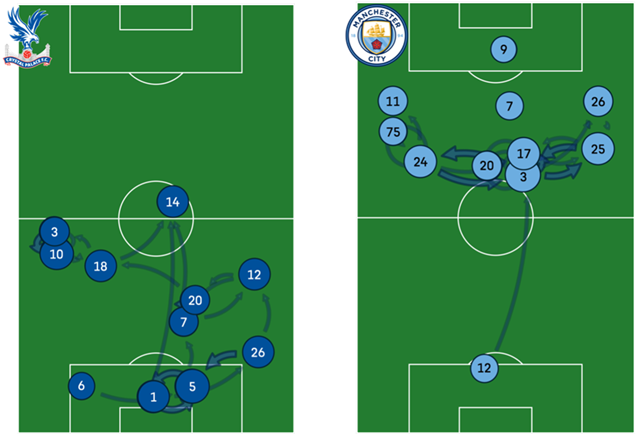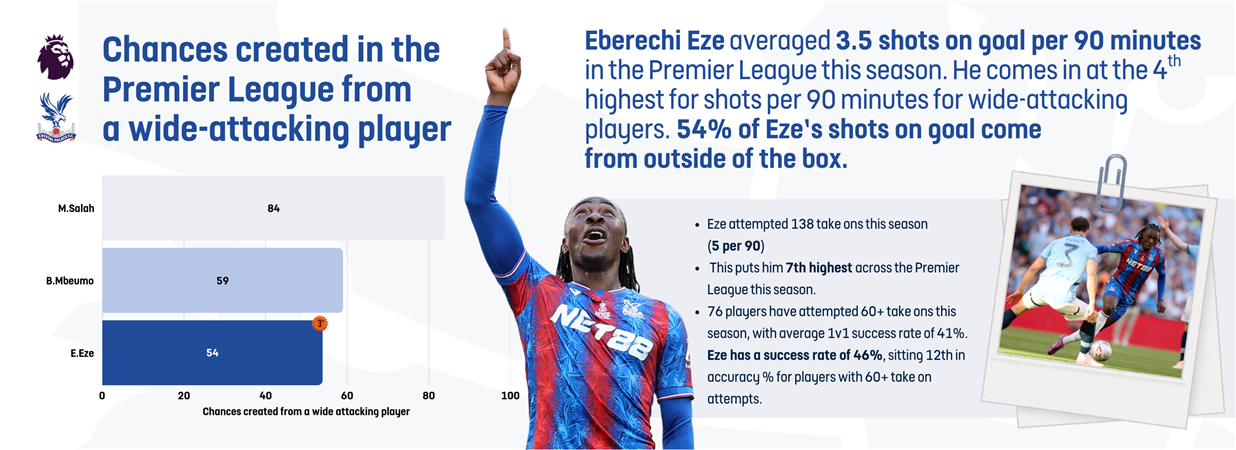At the end of the 2024/25 season, Crystal Palace achieved a historic 1–0 victory over Manchester City in the FA Cup final at Wembley Stadium, securing their first major trophy in club history. This win marks a significant milestone for Palace, ending a 164-year wait for a major trophy.
Eberechi Eze's first-half goal was the match-winner, and goalkeeper Dean Henderson played a crucial role, saving a penalty from Omar Marmoush and making key saves to secure Palace's first major trophy. Henderson's shot-stopping ability and commanding presence in the box were pivotal in thwarting City's attempts to equalise, despite Manchester City having a large portion of the momentum throughout the game. The graphic below, demonstrates just how much City dominated the game from start to finish. Cast your eyes to the momentum chart below the scoreline. Momentum in this graph focuses on ‘expected threat difference’, which is defined as the chance a goal will be scored in the next five actions. The frequency of white bars signifies the amount of time throughout the game Manchester City were in control.

However, this Palace triumph was not just a testament to individual brilliance, but also to a meticulously executed tactical plan that outsmarted one of Europe's elite teams. In this blog, FA Learning Experience Lead, Katie Sorenson delves into how Crystal Palace’s game approach won them the game.
Crystal Palace’s game approach
Under the guidance of Glasner, Palace have adopted a disciplined 1-3-4-2-1 formation, focusing on compact defending and then playing direct on transition, utilising the pace of individuals within their team on counter-attacks. This approach frustrated City's attacking prowess and neutralised their attacking threats. Palace's defensive unit of Chris Richards, Marc Guéhi and Maxence Lacroix executed Glasner's game plan with precision. They maintained a compact shape, denied City space in dangerous areas, and cleared their lines effectively. This collective defensive effort was crucial in keeping City's attacking threats at bay.
The strategy was clear: absorb City's pressure and then exploit the spaces left behind.

The above graphic demonstrates Palace’s approach to play over bigger distances, into their centre forward Jean-Philippe Mateta. In fact, 20% of their passes within the game were ‘long’ (ground pass longer than 45m or aerial pass longer than 25m). This is further confirmed with their ball progression speed within the game, as on average they progressed the ball up the pitch at a rate of 3.3m/s, demonstrating their direct approach to getting forward. This was almost double the speed of Manchester City, who instead adopted an approach that relied on ball retention to try and break down Palace’s out of possession structure.
Palace’s goal exemplified Palace's tactical approach under manager Oliver Glasner. The team's ability to absorb pressure and exploit spaces through quick transitions was evident. The interplay between Mateta, Kamada, and Muñoz highlighted the effectiveness of Palace's counter-attacking strategy, which proved crucial in overcoming a formidable Manchester City side.
The key cogs in Glasner’s game approach:
Wing-Backs: Daniel Muñoz and Tyrick Mitchell, Palace's wing-backs, were crucial in both defensive solidity and attacking support. Their ability to track back and join attacks provided balance to the team's play.
Midfield Control: Adam Wharton and Daichi Kamada anchored the midfield, breaking up City's rhythm and distributing the ball effectively. Wharton's progressive passing was particularly notable.
Counter-Attacking Threat: Eberechi Eze, Ismaila Sarr, and Jean-Philippe Mateta formed a dynamic attacking trio. Their pace and movement were key in exploiting City's defensive gaps during transitions.
Electrifying Eze
This season, Eberechi Eze has been in fantastic form for Crystal Palace. He has been a mainstay in the team, averaging 80 minutes per game in the Premier League, highlighting his importance within Glasner’s game model. In fact, of the 5 games he has played in the FA Cup this season, he has only missed 8 minutes of the action.
The insights below bring to life why he has been such a catalyst within the Eagles side.

Eze has lit up the Premier League and FA Cup this season, scoring 11 goals across 37 games. Alongside this, he also has 9 assists across both competitions, highlighting his playmaking ability. Eze has perfected his individual tactics, recognising the best ways he can gain an advantage in a match against his direct opponent. Watch the below video, to see how Eze has scored vital goals this season, through getting the upper hand in his 1v1 battles.
Crystal Palace's success in the FA Cup final highlighted the importance of tactical discipline, effective counter-attacking, and individual performances in achieving historic victories. So, what is next for Glasner’s high-flying Eagles next season?


